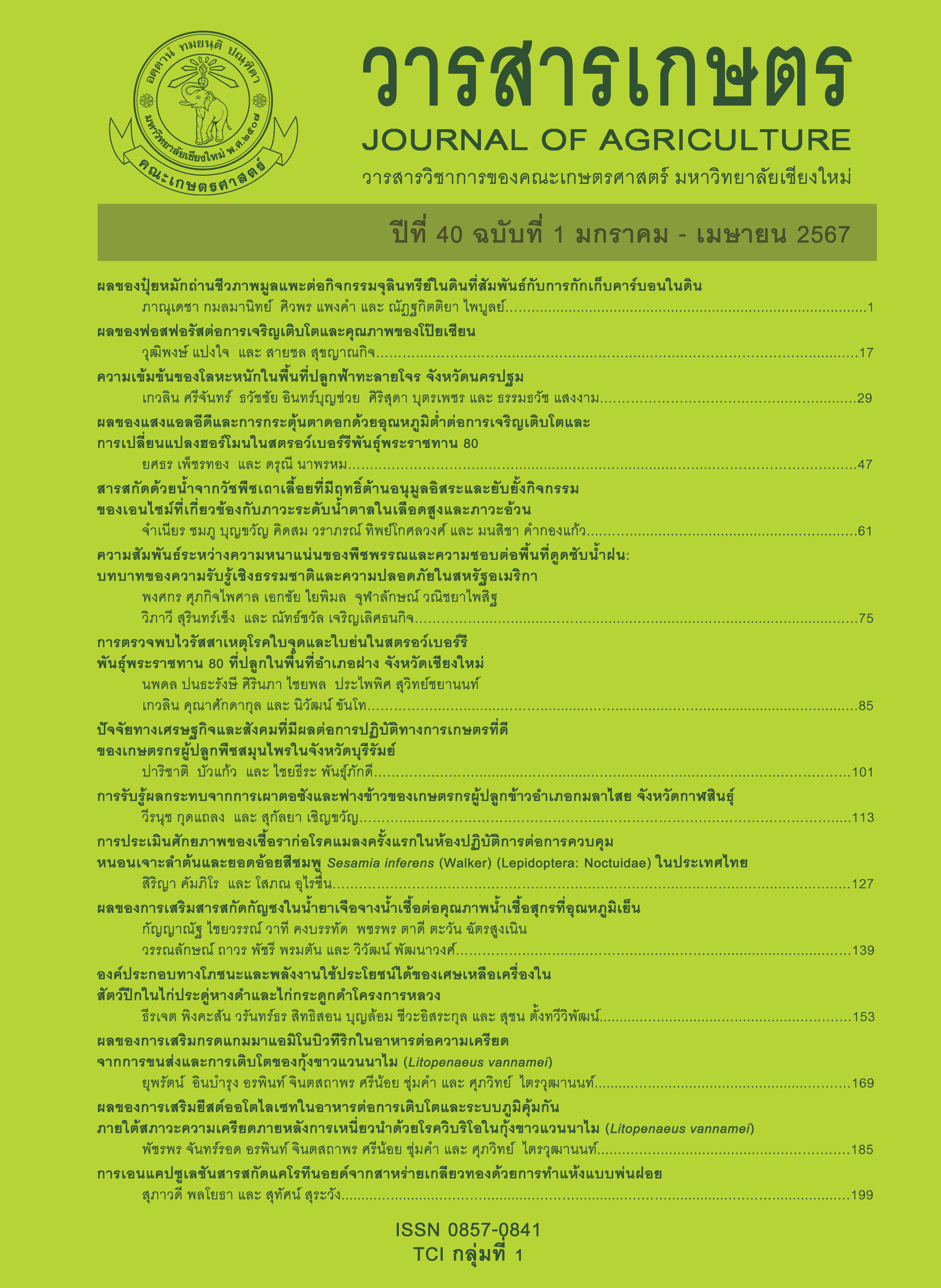การประเมินศักยภาพของเชื้อราก่อโรคแมลงครั้งแรกในห้องปฏิบัติการ ต่อการควบคุมหนอนเจาะลำต้นและยอดอ้อยสีชมพู <I>Sesamia inferens</I> (Walker) (Lepidoptera: Noctuidae) ในประเทศไทย
Main Article Content
บทคัดย่อ
เชื้อราสาเหตุโรคแมลงเป็นศัตรูธรรมชาติที่สำคัญของแมลงศัตรูพืช รวมถึงหนอนเจาะลำต้นและยอดอ้อยสีชมพู (Sesamia inferens (Walker) (Lepidoptera: Noctuidae)) ซึ่งจัดเป็นแมลงศัตรูที่สำคัญของอ้อยในประเทศ-ไทย ดังนั้น จึงได้ทำการศึกษาการประเมินประสิทธิภาพของเชื้อราสาเหตุโรคแมลงในการควบคุมหนอน S. inferens ขึ้นเป็นครั้งแรกภายใต้วัตถุประสงค์เพื่อตรวจสอบการก่อโรคและความรุนแรงของเชื้อราสาเหตุโรคแมลง 4 ชนิด 7 ไอโซเลท เชื้อรา Beauveria bassiana ไอโซเลท B001 เชื้อรา B. bassiana ไอโซเลท B002 เชื้อรา Fusarium sp. ไอโซเลท FSS เชื้อรา Metarhizium anisopliae ไอโซเลท M001 เชื้อรา M. anisopliae ไอโซเลท M002 เชื้อรา M. anisopliae ไอโซเลท MSS และ เชื้อรา Purpureocillium lilacinum ไอโซเลท PSS ซึ่งได้รับความอนุเคราะห์จากศูนย์วิจัยควบคุมศัตรูพืชโดยชีวินทรีย์แห่งชาติ ภาคกลาง มหาวิทยาลัยเกษตรศาสตร์ วิทยาเขตกำแพงแสน นครปฐม ในการควบคุมหนอน S. inferens ด้วยวิธีสัมผัสตาย ด้วยการหยดสารแขวนลอยโคนิเดียของเชื้อราสาเหตุโรคแมลงลงเฉพาะที่บริเวณเนื้อเยื่อปล้องอกระหว่างปล้องที่ 1 และปล้องที่ 2 ของหนอน S. inferens วัยที่ 4 ในระดับห้องปฏิบัติการ ในขั้นตอนแรกเป็นขั้นตอนการคัดกรองการเกิดโรคกับหนอน S. inferens จากเชื้อราที่ทดสอบทั้งหมด ผลจากการทดสอบมีเพียงเชื้อรา 2 ชนิด 3 ไอโซเลท ที่สามารถก่อโรคกับหนอน S inferens ได้แก่เชื้อรา B. bassiana ไอโซเลท B001 เชื้อรา M. anisopliae ไอโซเลท M001และ เชื้อรา M. anisopliae ไอโซเลท MSS ซึ่งทำให้หนอนมีอัตราการตาย 37.50 ± 5.80, 72.50 ± 9.60 และ 85.00 ± 5.80 เปอร์เซ็นต์ และค่า LT50 18.12, 6.03 และ 2.93 วัน ตามลำดับ จากนั้นนำผลการคัดกรองการเกิดโรคกับหนอน S. inferens ที่ทำให้มีอัตราการตายมากกว่า 50 เปอร์เซ็นต์ มาทำการทดสอบความ-รุนแรงของเชื้อราสาเหตุโรคแมลง พบว่า เชื้อรา M. anisopliae ไอโซเลท MSS มีความรุนแรงในการเข้าก่อโรคกับหนอน S. inferens ได้ดีกว่าเชื้อรา M. anisopliae ไอโซเลท M001 มีค่า LC50 เท่ากับ 4.73 x 105 และ 3.69 x 106 โคนิเดียต่อมิลลิลิตร ตามลำดับ ในขั้นสุดท้ายเป็นการนำเชื้อรา M. anisopliae ไอโซเลท MSS ซึ่งมีความรุนแรงที่สุดในการก่อโรคของเชื้อราทั้งหมดที่ใช้ทดสอบ มาทดสอบกับหนอน S. inferens วัย 2 - 3, 4 - 5 และ 6 - 7 เชื้อรา M. anisopliae ไอโซเลท MSS ดังกล่าวสามารถเข้าก่อโรคกับหนอน S. inferens มีค่า LC50 เท่ากับ 9.26x104, 6.02x105 และ 5.12 x 106 โคนิเดียต่อมิลลิลิตร ตามลำดับ
Article Details

อนุญาตภายใต้เงื่อนไข Creative Commons Attribution-NonCommercial-NoDerivatives 4.0 International License.
เอกสารอ้างอิง
Abbott, W.S. 1925. A method of computing the effectiveness of an insecticide. Journal of Economic Entomology 18(2): 265-267.
Attajarusit, J. 2001. Sugarcane borer and its control. Documentation for farmer training program on the Sugarcane Borer and Sugarcane White Leaf Disease Project. Division of Entomology and Zoology, Department of Agriculture, Bangkok. 17 p. (in Thai)
Attathom, T. 2003. Use of microorganisms to control insect pests. pp. 163-193. In: C. Chamswarng (ed.). Biological Control of Plant Diseases and Pests. Kasetsart University, Kamphaeng Saen Campus, Nakhon Pathom. (in Thai)
Bautista-Galvez, A., J.F. Barrera, E. Payro de la Cruz, S. Salgado-Garcia, J. Gomez-Ruiz and J.E. Gomez-Leyva. 2012. Genetic Characterisation of Metarhizium anisopliae (Metchnikoff) Sorokin isolates from sugarcane fields and their pathogenicity against Aeneolamia postica (Walker) (Hemiptera: Cercopidae). Universidad Ciencia 28(3): 217-229.
Celestino, M. and J.A. dos S. Oliveira. 2022. Encapsulation methods of entomopathogenic fungi for their application in the biological control. Research, Society and Development 11(16): DOI: https://doi.org/10.33448/rsd-v11i16.38031 (Abstract)
Elena, G.J., P.J. Beatriz, P. Alejandro and E. Roberto. 2011. Metarhizium anisopliae (Metschnikoff) Sorokin Promotes growth and has endophytic activity in tomato plants. Advances in Biological Research 5 (1): 22-27.
Finney, D.J. 1952. Probit Analysis. 2nded. Cambridge University Press, New York. 256 p.
Kokkan, P., N. Siri and N. Pitaksa. 2008. The effect of stem borers infestations on yield and quality of 8 sugarcane varieties. Khon Kaen Agriculture Journal 36(Suppl.): 165-171. (in Thai)
Maneerat, T., S. Rattanakaand and W. Suasa-ard. 2006. Comparative study for foodstuff of Sesamia inferens (Walker) (Lepidoptera: Noctuidae) for Cotesia flavipes (Cameron) (Hymenoptera: Braconidae) production. pp. 390-395. In: Proceedings of 44th Kasetsart University Annual Conference: Plants. Kasetsart University, Bangkok. (in Thai)
Meirelles, L.N., E. Mesquita, T.A. Correa, R. de O.B. Bitencourt, J.L. Oliveira, L.F. Fraceto, M.G. Camargo and V.R.E.P. Bittencourt. 2023. Encapsulation of entomopathogenic fungal conidia: evaluation of stability and control potential of Rhipicephalus microplus. Ticks and Tick-borne Diseases 14: 102-184.
Mehinto, J.T., P. Atachi, O.K.D. Kpindou, E.A. Dannon and M. Tamò. 2014. Mortality of Maruca vitrata (Lepidoptera: Crambidae) larval stages induced by different doses of the entomopathogenic fungi Metarhizium anisopliae and Beauveria bassiana. International Journal of Advanced Research 2(4): 273-285.
Mekapogu, A.R. 2021. Finney’s probit analysis spreadsheet calculator (Version 2021). (Online). Available: https://probitanalysis.wordpress.com/ (December 12, 2021).
Patirupanusara, P. 2011. The role of insect fungi in controlling insect pests. Phitsanulok Rice Research Center Phitsanulok. 184 p. (in Thai)
Pitak, N. 2001. Alternative technologies for IPM. pp. 241-255. In: Proceedings of the 4th Academic Symposium on the Prevention and Control of Sugarcane Insect Pests by Integrated Methods. Division of Entomology and Zoology, Department of Agriculture, Bangkok. (in Thai)
Siqueira, A.C.O.G., M. Mascarin, C.R.N.C.B. Gonçalves, J. Marcon, M.C. Quecine, A. Figueira and I. Delalibera Jr. 2020. Metarhizium species and their activities that stimulate the growth of tomato plants. Frontier in Sustain. Food System Volume 4: 1-15.
Thungrabeab, M. 2018. Entomopathogenic Fungi as Alternatives for Insect Pest Control. O.S. Printing House CO., LTD. Bangkok. 240 p. (in Thai)
Tonphukhiaw, V., N. Siriand and T. Jamjanya. 2018. Mass rearing technique of pink stem borer, Sesamia inferens (Walker) (Lepidoptera: Noctuidae) using baby corn for Larval Parasitoid, Cotesia flavipes (Cameron) (Hymenoptera: Braconidae) production. Khon Kaen Agriculture Journal 46(5): 975-982.
Tuncer, C. and O. Aker. 2017. Sexual Dimorphism in the Pupal Stage of Hyphantria Cunea (Lepidoptera: Erebidae). Entomological News 127(2): 112-116.
Varma, A. and B.K. Tandan. 1996. Pathogenicity of three entomogenous fungi against insect pests of sugarcane. Journal of Biological Control 10(1&2): 87-91.
Varma, A., B.K. Tandanand and K. Singh. 1988. First record of Beauveria bassiana (Balsamo) Vuillemin, an entomogenous fungus from the sugarcane defoliator Phytoscaphus sp. (Coleoptera: Curculionidae) from India. Current Science 57(7): 396.
Wangspa, W., Y. Chanbang and S. Vearasilp. 2015. Radio frequency heat treatment for controlling rice weevil in rough rice cv. Khao Dawk Mali 105. Journal of Natural Sciences 14(2): 189-197.


